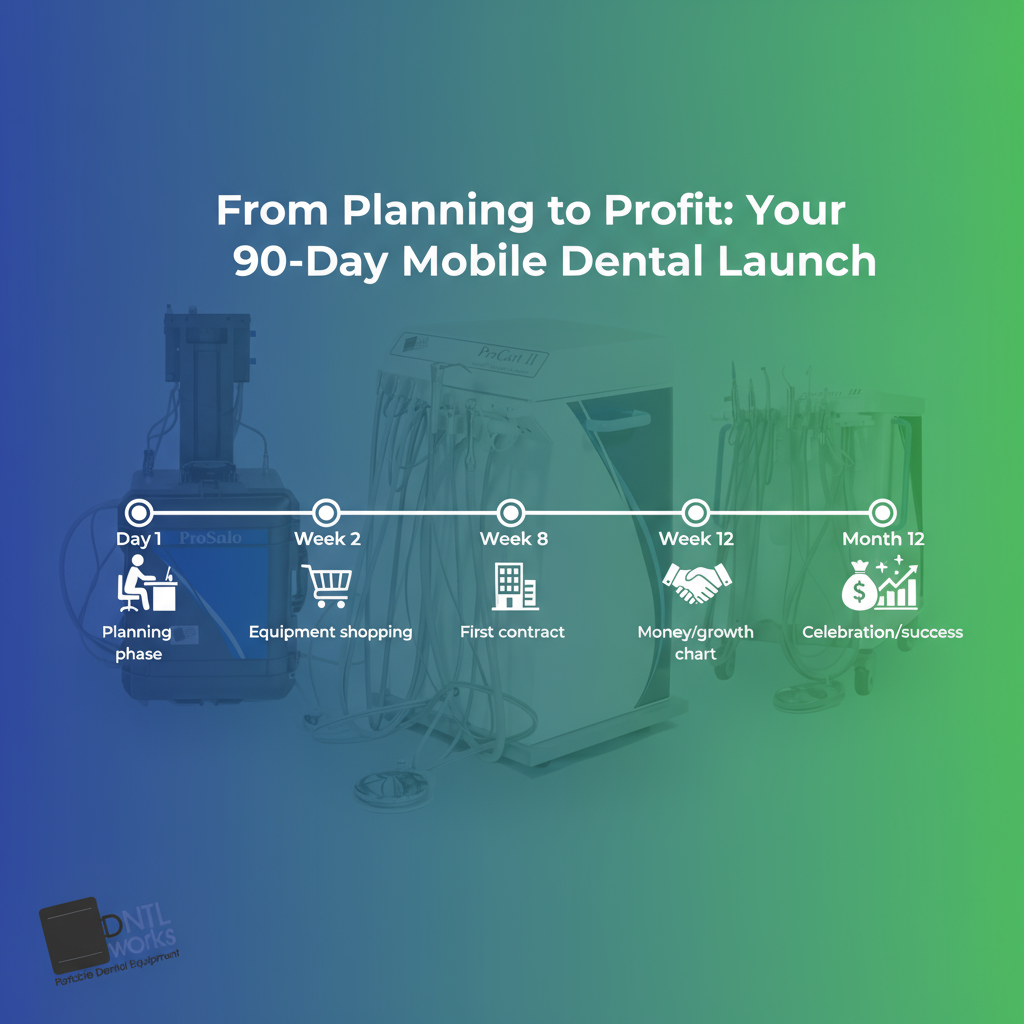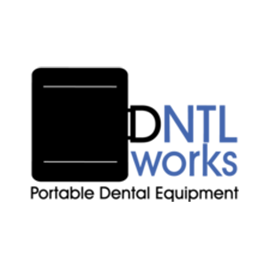
Share
How to Start a Mobile Dental Practice in 2025
The complete step-by-step guide: From planning to your first patient in 12 weeks
Reading time: 25 minutes | Last updated: October 2025 | Based on: 36 years of mobile dental equipment expertise
📋 Your 90-Day Roadmap
Weeks 1-4: Pre-Launch
- Market research
- Business model selection
- Legal structure & licensing
- Insurance setup
Weeks 5-6: Equipment
- Equipment selection
- Financing options
- Vehicle setup
- Supply ordering
Weeks 7-8: Operations
- Systems setup
- Sterilization protocols
- Scheduling software
- Practice workflows
Weeks 9-12: Launch
- Contract acquisition
- Marketing execution
- First patients
- Scaling strategy
Why This Guide Exists
Here's the problem: Most dentists who want to go mobile don't know where to start.
They see the opportunity—153 million underserved Americans, lower overhead, flexible schedules, meaningful impact. But then they get stuck on the questions:
- "What equipment do I actually need?"
- "How do I get contracts with nursing homes?"
- "What about licensing and liability?"
- "Can I really be profitable without a traditional office?"
- "Where do I even start?"
This guide answers every single one of those questions—in order, with specifics, backed by 36 years of mobile dental equipment expertise and real provider data.
We're not going to theorize or give you vague advice. This is a 90-day implementation plan that takes you from "I'm thinking about mobile dentistry" to "I just treated my 20th patient this month."
The Promise
Follow this guide step-by-step, and in 90 days you'll have a fully operational mobile dental practice ready to serve patients and generate revenue.
Let's get started.
Pre-Launch Planning
This is where most people want to rush. Don't. The decisions you make in the first 4 weeks determine whether you build a sustainable practice or struggle for years.
Week 1: Market Research & Opportunity Assessment
Goal: Identify your target market and validate demand.
✅ Action Items:
- Map your service area: Draw a 30-50 mile radius around your location. This is your realistic service zone.
- Count facilities: Use Google Maps to identify all nursing homes, assisted living facilities, schools, and correctional facilities in your zone.
- Research competition: Call 10 facilities and ask: "Do you currently have a mobile dental provider?" Document who's serving them and how often.
- Calculate TAM (Total Addressable Market): If you have 20 nursing homes averaging 100 beds each = 2,000 potential patients.
- Validate demand: Cold call 5 facilities. Ask administrators if they'd be interested in mobile dental services. You're looking for "YES" or "Tell me more."
📊 Quick Math Check:
If you secure contracts with just 5 nursing homes (100 beds each) and treat 10% of residents monthly at $200/visit, that's 50 patients × $200 = $10,000/month revenue. And you haven't even maxed out your capacity yet.
Week 2: Business Model Selection
Not all mobile practices are created equal. Choose the model that fits your goals, market, and resources.
Business Model Comparison
Model 1: Nursing Home Circuit
Best for: Dentists seeking predictable revenue and B2B relationships.
Pros: High revenue potential, contracted income, professional setting
Cons: Higher equipment investment, facility politics, medical complexity
Model 2: School-Based Programs
Best for: RDHs or dentists focused on prevention and community impact.
Pros: Grant funding available, high volume, meaningful work
Cons: Lower per-patient revenue, seasonal schedule, compliance heavy
Model 3: Hybrid Practice
Best for: Existing practitioners wanting to expand reach without abandoning office.
Pros: Diversified revenue, risk mitigation, scheduling control
Cons: Complex logistics, higher total overhead, split focus
💡 Decision Framework:
Choose Nursing Home Circuit if: You want maximum revenue and have $18K-25K for equipment.
Choose School-Based if: You're hygiene-focused or want grant funding support.
Choose Hybrid if: You have an existing practice and want to test mobile before committing fully.
Week 3: Legal Structure & Licensing
Non-negotiable: Get this right. Cutting corners here creates expensive problems later.
✅ Legal Checklist:
- Choose business structure: Most mobile practices choose LLC (liability protection) or S-Corp (tax benefits). Consult a CPA—this decision affects taxes for years.
- Register business name: Check availability, file DBA if needed. Pro tip: Make it descriptive ("Mobile Dental Care of [City]" > "Smile Solutions").
- Obtain EIN: Free from IRS. Takes 5 minutes online. You need this for bank accounts and contracts.
- Apply for dental license (if needed): Some states require separate mobile or public health permits. Check your state dental board website.
- Facility permits: Nursing homes may require TB tests, background checks, facility-specific credentialing. Start these NOW—they take 2-4 weeks.
- OSHA compliance: You're still subject to infection control standards. Download the ADA's mobile dentistry compliance guide.
⚠️ Common Mistakes:
- Not checking if your state requires special mobile permits (some do!)
- Skipping facility credentialing and getting rejected at the door
- Operating as sole proprietor (bad idea—get that liability protection!)
Week 4: Insurance & Liability Setup
Insurance isn't sexy, but it's non-negotiable. Most facilities won't contract with you without proper coverage.
Required Coverage:
1. Malpractice Insurance
Minimum: $1M per occurrence, $3M aggregate
Cost: $3,000-8,000/year
Providers: TDIC, Dentist's Advantage, Berxi
2. General Liability
Minimum: $1M coverage
Cost: $500-1,500/year
Covers: Slip-and-fall, property damage at facilities
3. Commercial Auto
Why: Personal auto won't cover business use
Cost: $1,200-2,500/year
Covers: Equipment in transit, business driving
4. Equipment Insurance
Why: ProCart III is $12,689—protect it
Cost: $300-800/year
Covers: Theft, damage, loss
💰 Total Insurance Budget: $5,000-12,000/year
Yes, it's expensive. But one lawsuit without coverage will cost you 10-100x more. This is non-negotiable.
✅ Pre-Launch Completion Checklist
☑️ Market validated (5+ interested facilities)
☑️ Business model selected
☑️ LLC/S-Corp registered
☑️ EIN obtained
☑️ Licenses verified
☑️ Insurance coverage secured
Equipment Selection
This is where theory becomes reality. The equipment you choose determines your patient capacity, clinical capability, and profitability.
The Critical Decision
Don't cheap out here. Your equipment is your practice. A $7,000 ProSolo that handles 8 patients/day limits your revenue. A $12,689 ProCart III that handles 20+ patients/day pays for itself in weeks. Do the math.
DNTLworks Delivery Unit Comparison
ProSolo
$5,188
Best for: Testing mobile waters, hygiene-focused, part-time mobile
Patient capacity: 8 per day
Pros: Low entry price, 6 mounting options, proven reliability
Cons: Limited capacity, basic features, revenue ceiling
ProSeal II
$8,746
Best for: Hygienists building independent practices, school programs
Patient capacity: 15 per day
Pros: Hygiene-optimized, portable, quiet operation
Cons: Preventive-only, not for restorative work
ProCart III
$12,689
Best for: Full-time mobile practice, nursing home circuits, maximum revenue
Patient capacity: 20-24 per day
Pros: Full restorative capability, highest capacity, trusted by military
Cons: Higher upfront cost (but highest ROI)
Total Equipment Investment Breakdown
Complete Equipment Package (ProCart III Setup)
Core Equipment
- ProCart III Delivery Unit: $12,689
- Supreme Portable Chair: $5,500
- Operator Stool: $600
- Operatory Light: $1,300
Subtotal: $20,089
Supplies & Accessories
- Initial dental supplies: $1,500
- Sterilization kit: $1,000
- Portable X-ray (optional): $6,221
- PPE & infection control: $500
Subtotal: $3,000-9,221
Business Setup
- Marketing materials: $500
- Business cards, brochures: $200
- Website (basic): $300
- Working capital: $2,000
Subtotal: $3,000
Total Investment Range:
$26,000 - $32,000
(Without X-ray: $26K | With X-ray: $32K)
💰 Financing Options
1. Equipment Financing
Terms: 24-60 months
Rates: 5-12% APR
Down payment: 10-20%
ProCart III payment: ~$250-350/month
2. Business Line of Credit
Amount: $10K-50K
Use: Equipment + working capital
Pros: Flexibility, only pay interest on what you use
Providers: BlueVine, Kabbage, banks
3. SBA Microloan
Amount: Up to $50K
Terms: Lower rates (6-9%)
Requirements: Business plan, good credit
Timeline: 4-8 weeks to approval
💡 Smart Financing Strategy:
Finance the equipment (ProCart III, chair) and pay cash for supplies. This preserves cash flow while spreading equipment costs over the revenue-generating period. Most mobile practices break even on equipment payments within 3-6 months.
Ready to Choose Your Equipment?
If you're serious about full-time mobile practice and want maximum revenue potential, the ProCart III is the proven choice. If you're testing the market or focusing on hygiene, start with ProSolo or ProSeal II.
Operations Setup
You have your equipment. Now let's build the systems that make your practice run smoothly.
Vehicle Selection & Setup
Bottom line: You need a vehicle that's reliable, has room for equipment, and looks professional.
✅ Best Options:
- Minivan (Honda Odyssey, Toyota Sienna)
- SUV (Honda Pilot, Toyota Highlander)
- Small cargo van (Ford Transit Connect)
Key Features:
- Fold-flat seats for equipment
- Good gas mileage (lots of driving)
- Reliable (you can't miss appointments)
- Clean, professional appearance
Modifications:
- Cargo organizers ($100-300)
- Tie-down straps (secure equipment)
- Weathertech mats (easy cleaning)
- Optional: Vehicle wrap with branding
⚠️ Don't Do This:
Don't show up to a professional facility in a beat-up personal car with dental equipment rattling around loose. First impressions matter. Your vehicle is part of your brand.
Sterilization & Infection Control Protocols
Mobile doesn't mean compromised infection control. You're still subject to OSHA and CDC guidelines.
Required Equipment:
- Portable autoclave: Statim or equivalent ($3,000-5,000)
- Sharps containers: Mounted in vehicle, proper disposal contracts
- Biohazard bags: Red bags for contaminated materials
- Surface disinfectants: EPA-registered, facility-approved
- PPE stock: Gloves, masks, gowns, eye protection (3-month supply)
✅ Mobile Workflow:
- Set up with clean field protocols
- Treat patients using standard precautions
- Bag contaminated instruments in sealed pouches
- Return to home base/storage unit
- Autoclave instruments for next day
- Restock supplies weekly
Scheduling Systems & Practice Management
Mobile practices need flexible, cloud-based systems you can access from anywhere.
Practice Management
Recommended: Dentrix Ascend, Curve Dental, Open Dental
Must-haves: Cloud-based, mobile app, insurance billing
Cost: $200-500/month
Scheduling Tools
Options: Calendly, Acuity, built-into PM software
Use: Facility coordination, patient appointments
Cost: $0-50/month
Route Planning
Tools: Google Maps, Route4Me
Purpose: Optimize facility visits, minimize drive time
Impact: See 1-2 extra patients/day
Market Entry Strategy
Equipment is ready. Systems are in place. Now it's time to get contracts and patients.
The Nursing Home Contract Playbook
The Cold Outreach Script That Works
"Hi, I'm Dr. [Name], and I run a mobile dental practice serving nursing homes in [area]. I'm calling because I noticed [Facility Name] doesn't currently have a contracted dental provider, and I wanted to see if you'd be interested in discussing monthly on-site dental services for your residents."
[Pause for response]
"We bring all equipment on-site—portable dental chair, X-rays, everything. Residents receive care in their rooms or in a designated space. No transportation needed. Most facilities love it because it improves resident health and family satisfaction."
"I'd love to schedule 15 minutes to meet with you and show you how it works. Are you available this week or next?"
📈 Conversion Metrics to Expect:
- Cold calls: 20% will take a meeting
- Meetings: 40-50% convert to contracts
- To get 5 contracts: Call 50-60 facilities
- Timeline: 4-6 weeks from first call to signed contract
Your 90-Day Launch: The Bottom Line
You now have the complete roadmap. Let's recap what you know:
The 90-Day Reality Check
- Investment: $20,000-35,000 to start
- Timeline: 90 days from planning to first patient
- Year 1 Revenue Potential: $180,000-300,000
- Break-Even: Month 3-6 typically
- Patient Capacity: 20-24 per day with ProCart III
Mobile dentistry isn't a compromise. It's not "dentistry for people who can't afford a real office."
It's a smarter business model that serves populations traditional dentistry can't reach, with lower overhead, flexible scheduling, and meaningful impact.
Ready to Start Your
90-Day Journey?
The equipment, systems, and strategies are proven. The market is massive and underserved. The only question left is: When do you start?
DNTLworks Equipment Corporation
Proudly Made in USA Since 1986
Serving 65+ Countries Worldwide
100+ Products Engineered for Mobile Dentistry
